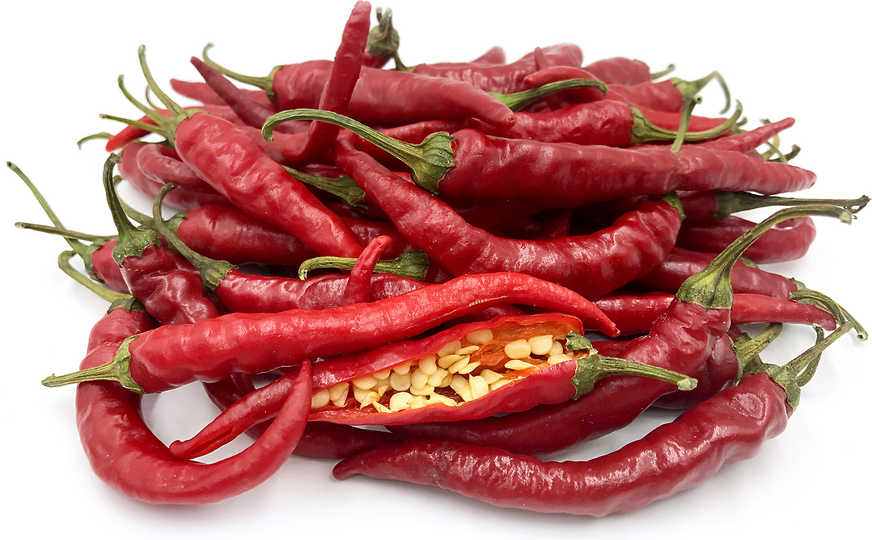


Hot Portugal Chile Peppers
Estimated Inventory, lb : 0
Description/Taste
Hot Portugal chile peppers are elongated, curved to straight pods, averaging 12 to 20 centimeters in length, and have a conical shape that tapers to a point on the non-stem end. The pods may appear very twisted and curved, and the skin is wrinkled or smooth, waxy, and glossy, ripening from green to dark red when mature. Underneath the surface, the flesh is thin, crisp, and aqueous, encasing a central cavity filled with many round and flat, cream-colored seeds. Hot Portugal chile peppers have a subtle, sweet flavor mixed with a moderate to hot level of spice that lingers on the palate.
Seasons/Availability
Hot Portugal chile peppers are available in the summer through early fall.
Current Facts
Hot Portugal chile peppers, botanically classified as Capsicum annuum, are spicy, elongated peppers that belong to the Solanaceae or nightshade family. Considered to be one of the earliest ripening varieties, Hot Portugal chile peppers are moderate to hot, ranging 5,000-30,000 SHU on the Scoville scale and have the ability to occasionally peak at 50,000 SHU. With their spicy reputation, the peppers have become a popular home garden variety, but the peppers must be labeled when planted as they are extremely difficult to distinguish from Jimmy Nardello chile peppers. Hot Portugal chile peppers are favored for their sweet heat and are commonly used in hot sauces.
Nutritional Value
Hot Portugal chile peppers are an excellent source of vitamins A, C, and B-complex vitamins and contain minerals like potassium, iron, and folate. The peppers also contain the chemical compound known as capsaicin, which triggers pain receptors in our body to feel the sensation of burning. Capsaicin has been shown to have anti-inflammatory properties and causes the body to release endorphins to counteract the perceived pain.
Applications
Hot Portugal chile peppers can be used in raw applications such as sauces, salsas, and marinades, but due to their spicy nature, they are often utilized in cooked preparations such as simmering, stir-frying, and roasting. It is important to note that gloves should be worn when handling the peppers, as capsaicin can irritate the skin. Hot Portugal chile peppers can be added to soups, chilis, or stews, lightly stir-fried with vegetables for additional heat, roasted and blended into hot sauce, or stuffed with grains, meats, and cheeses. The peppers also dry well and can be crushed to make red chile flakes. Hot Portugal chile peppers pair well with mushrooms, ginger, onions, garlic, meats such as pork, pancetta, beef, and poultry, shrimp, arugula, spinach, fig, cauliflower, and spices such as turmeric and cumin. Fresh peppers will keep up to one week when loosely stored whole and unwashed in a paper or plastic bag in the refrigerator.
Ethnic/Cultural Info
In Portugal, hot peppers are used to make pimenta moida or Portuguese style ground red peppers. The sauce is traditionally made each fall, and Portuguese families typically make enough to last them for over a year. Recipes will differ between households, and each family adds its own secret ingredients, but the peppers are purchased in large quantities at the local market, deseeded, put through a meat grinder in the backyard, and then left to ferment with salt and preservative powder. The sauce is considered a Portuguese specialty and is used on fish, grilled meats, eggs, and as a spread on bread.
Geography/History
Hot Portugal chile peppers are descendants of peppers native to Central and South America that were spread across the world via Spanish and Portuguese explorers in the 15th and 16th centuries. The exact history of Hot Portugal chile peppers is unknown, but some experts believe the peppers were first made popular in Portugal, while others believe the peppers were developed in the United States in the 1920s. Regardless of its origins, Hot Portugal chile peppers were first offered in the United States by Harris Seeds, a company owned by Joseph Harris of Coldwater, New York. The seed was then given to Seed Savers Exchange in 1935 and was introduced to the market as a new long, hot pepper. Today Hot Portugal chile peppers can be found through small farms at local farmer’s markets in Europe and the United States and through online seed catalogs for home garden use.
Recipe Ideas
Recipes that include Hot Portugal Chile Peppers. One
| Leite's Culinaria |
|
Portuguese Hot Sauce |
| Food dot com |
|
Portuguese Hot Pepper Paste |




